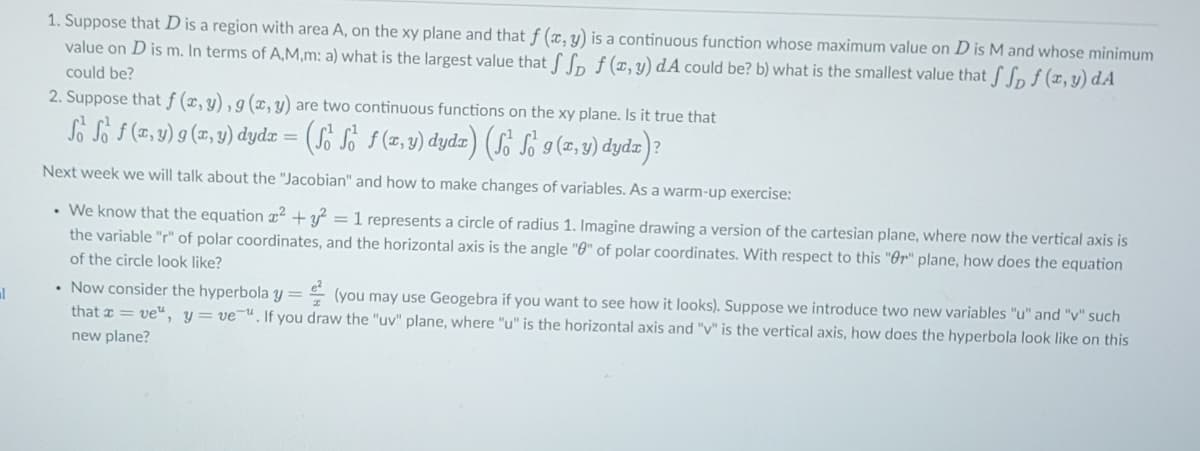2. Suppose that f (x, y), g(x, y) are two continuous functions on the xy plane. Is it true that So So f (x, y) 9 (x,y) dydx = ( f f (x,y) dydr) (S f 9 (x, y) dyda)?
2. Suppose that f (x, y), g(x, y) are two continuous functions on the xy plane. Is it true that So So f (x, y) 9 (x,y) dydx = ( f f (x,y) dydr) (S f 9 (x, y) dyda)?
Algebra & Trigonometry with Analytic Geometry
13th Edition
ISBN:9781133382119
Author:Swokowski
Publisher:Swokowski
Chapter9: Systems Of Equations And Inequalities
Section: Chapter Questions
Problem 12T
Related questions
Question
Please help me with part 2 of this Multivariable Calculus homework. Thanks

Transcribed Image Text:al
1. Suppose that D is a region with area A, on the xy plane and that f (x, y) is a continuous function whose maximum value on D is M and whose minimum
value on D is m. In terms of A,M,m: a) what is the largest value that SSD f (x,y) dA could be? b) what is the smallest value that f f f (x,y) dA
could be?
2. Suppose that f(x, y), g(x, y) are two continuous functions on the xy plane. Is it true that
So So f (x, y) 9 (x, y) dydx = (So f f (x, y) dydr) (So So 9 (x, y) dydx)?
Next week we will talk about the "Jacobian" and how to make changes of variables. As a warm-up exercise:
. We know that the equation x² + y² = 1 represents a circle of radius 1. Imagine drawing a version of the cartesian plane, where now the vertical axis is
the variable "r" of polar coordinates, and the horizontal axis is the angle "0" of polar coordinates. With respect to this "r" plane, how does the equation
of the circle look like?
• Now consider the hyperbola y = (you may use Geogebra if you want to see how it looks). Suppose we introduce two new variables "u" and "v" such
that = ve", y=ve". If you draw the "uv" plane, where "u" is the horizontal axis and "v" is the vertical axis, how does the hyperbola look like on this
new plane?
Expert Solution
This question has been solved!
Explore an expertly crafted, step-by-step solution for a thorough understanding of key concepts.
This is a popular solution!
Trending now
This is a popular solution!
Step by step
Solved in 2 steps with 2 images

Recommended textbooks for you

Algebra & Trigonometry with Analytic Geometry
Algebra
ISBN:
9781133382119
Author:
Swokowski
Publisher:
Cengage

Algebra & Trigonometry with Analytic Geometry
Algebra
ISBN:
9781133382119
Author:
Swokowski
Publisher:
Cengage